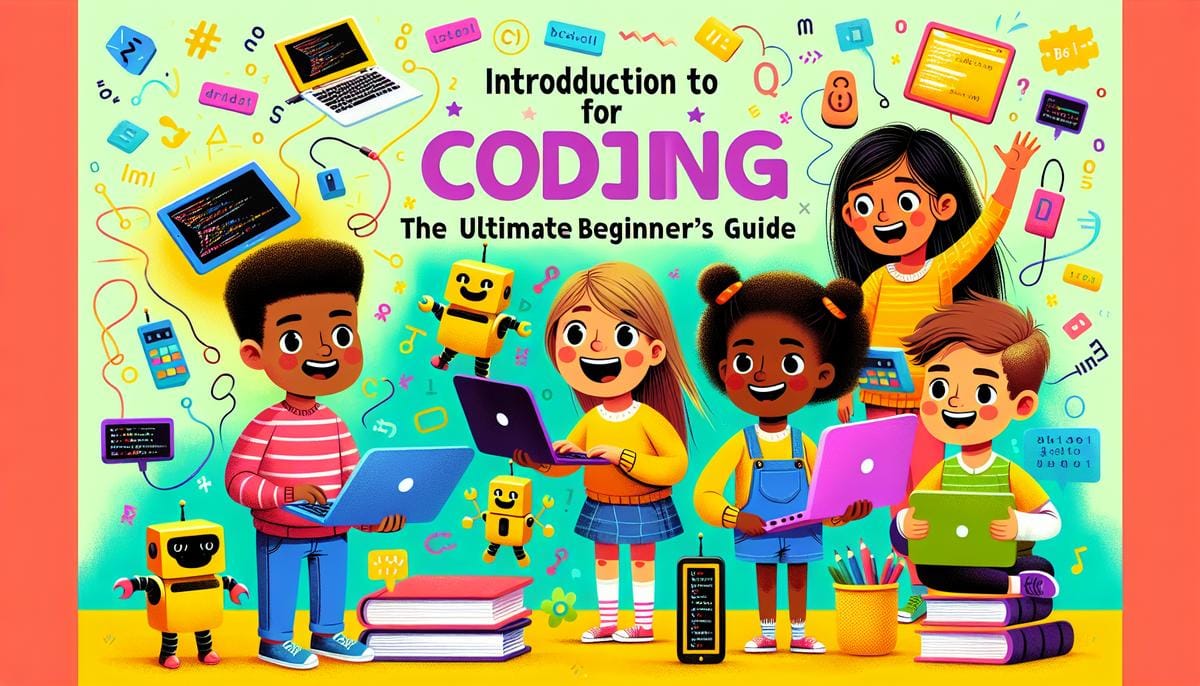Introduction to Coding for Kids: The Ultimate Beginner's Guide

Welcome to the exciting world of coding! In this guide, we will take you on a journey through the basics of coding, why it is a must-have skill for kids, how to choose the right programming language, and where to find the best coding resources. Whether coding is an uncharted territory for you and your child or you are looking for more ways to expand their coding skills, this guide is your one-way ticket to making coding a fun and rewarding experience for your child.
The Basics of Coding
Let's start by demystifying what coding is all about. Imagine you could tell your computer or smartphone exactly what to do, whether it's drawing a picture, playing a song, or solving a math problem. That's exactly what coding allows you to do! It is a way to create step-by-step commands that computers understand and act upon. Coding is like writing a recipe for a computer to follow.
The first concept every young coder needs to understand is an algorithm. An algorithm is a set of instructions designed to perform a specific task. Kids use algorithms all the time without even realizing it. For example, when they follow steps to make a sandwich or tie their shoelaces – that's an algorithm! In coding, algorithms are the foundational structures that guide the computer to execute various actions.
Next comes the sequence. In coding, the sequence is important because computers read code in order, from top to bottom, just like reading a book. Each line of code is a step that needs to be executed before moving to the next one. A problem in the sequence could cause the program to behave unexpectedly, which is why attention to detail is essential.
Another fundamental concept is loops. Loops are powerful coding structures that tell a computer to repeat a set of instructions until a certain condition is met. This is incredibly useful because it saves a coder from writing the same code over and over again for repetitive tasks. For example, if we want the computer to count from 1 to 10, we don't have to write ten different lines of code. Instead, we can use a loop to repeat the instruction of incrementing the number by one until it reaches ten.
Why Kids Should Learn to Code
In the digital age, coding has become a basic literacy. It's an essential skill that not only opens a world of opportunities for children but also enriches their personal growth. One of the key benefits of learning to code is that it teaches kids problem-solving skills. Coding challenges children to break down complex problems into smaller, more manageable parts, and to think logically about how to solve them.
Creativity is another significant benefit. Coding is not about following a set of instructions; it's about creating and bringing ideas to life. When kids learn to code, they learn that they have the power to build their own games, animations, and websites, which can be incredibly empowering. Additionally, coding is often described as 'fun' by kids. They enjoy the process of taking an abstract idea and turning it into something interactive and tangible.
Moreover, coding has a positive impact on academic performance. It helps reinforce math skills as coding involves a lot of mathematics and logical thinking. It allows children to visualize abstract concepts, lets them apply math to real-world situations, and makes learning math fun and creative. Furthermore, coding can improve writing skills as it encourages young coders to organize their thoughts and communicate them clearly— skills that are broadly transferable and useful in all areas of life.
Choosing the Right Coding Language
Now that we've covered why coding is awesome, let's talk about how to pick the right coding language for your child. Each coding language has its own syntax or set of rules on how the commands should be written, but don't let that intimidate you or your champs. While there are more advanced languages like C++ or Java, there are also plenty of beginner-friendly languages designed with kids in mind.
Scratch, for example, is a fantastic starting point for young children. It uses a visual drag-and-drop interface, which means children can create code by stacking colored blocks together, rather than typing out text. It's designed by the MIT Media Lab and is a wonderful way to introduce programming concepts without overwhelming beginners with complex codes.
For kids a bit older, Python is a great choice. It is a powerful, expressive language used by professional programmers for websites like YouTube and Instagram, but its syntax is clear and readable, which makes it excellent for beginners. Python uses real coding syntax but is forgiving for new coders and is great for creating simple scripts and games.
JavaScript, while a bit more advanced, is the language of the web. It's a great choice for kids interested in web development and creating interactive elements on websites. JavaScript code can be run on any web browser, and since almost everything is on the internet these days, the potential to create with JavaScript is nearly endless.
Choosing the right coding language depends on your child's interest, age, and the kind of projects they're excited about. Remember, the best language to learn is the one that they will engage with and enjoy! The key is to start simple and build up from there.
Coding Resources for Kids
With the internet at our fingertips, there are more resources available for learning to code than ever before. A wealth of interactive tutorials, games, and coding platforms can make the learning experience engaging and fun for kids of all ages. Let's explore some of the best resources that will turn your child into a mini coding wizard.
Online platforms like Code.org provide a range of activities and tutorials that make coding accessible to kids of all ages and abilities. It features content that is tied to popular culture, like Minecraft coding tutorials or Frozen-themed coding games, which makes learning relevant and exciting.
Tynker is another popular choice, with a curriculum that scales with your child as they grow. Starting with visual block coding and moving into real-world programming languages, Tynker offers a structured learning path and hundreds of hours of content that develops critical 21st-century skills.
Khan Academy's computing section also offers free tutorials on a variety of programming topics and languages, including JavaScript and SQL, while coding apps like Hopscotch and ScratchJr provide a platform for younger children to create their own games and stories through interactive puzzles.
When looking for coding resources, it's important to consider your child's learning style. Some kids might prefer the structured lessons of an online course, while others might thrive with a more open-ended platform that allows for creative expression. Whatever the preference, there's something out there for every aspiring young coder.
Coding Projects for Kids
Once your child has gotten the hang of some coding basics and has begun experimenting with a language that resonates with them, it's time to start applying what they've learned to real-world projects. Projects are an excellent way for kids to see the results of their hard work, and they can be incredibly motivating. The sense of accomplishment that comes from completing a project is priceless — it boosts confidence and fuels the desire to learn more.
One fun project idea is for kids to design their own interactive story or a comic strip. They can use coding to bring characters to life, create animations, or even make games out of their stories. Scratch, with its visually appealing block-code interface, is a great platform for such storytelling projects. Kids can use different sprites (characters), backgrounds, and sounds to make their stories unique and interactive.
Another exciting project can be building a simple website. Starting with HTML and CSS, which control the structure and style of web pages respectively, kids can create their own personal webpage. They can design a portfolio to showcase their projects, a blog to document their coding journey, or an informative website on a subject they're passionate about. Learning to code a website inspires kids to think critically about layout, design, and user experience.
For the future game designers, creating a small video game is an extraordinary project. They can practice skills like logical thinking, creativity, and even storytelling. By designing characters, levels, and gameplay mechanics, children can develop a game that's entirely their own. Coding a game can start from the simple - like a clone of the classic Pong - to something more complex, based on their proficiency level.
Remember, the key to a successful coding project is not perfection but progress. Encourage your child to start small, learn from errors, and iterate. Coding is as much about problem-solving and grit as it is about technical know-how. Patience and persistence will lead to rewarding outcomes that inspire continued learning.
Conclusion
Coding has evolved from a niche activity to a fundamental skill for the next generation. By learning to code, children acquire more than just the ability to program a computer; they learn a new way to think about the world. Coding offers kids a powerful tool for expressing creativity, with endless possibilities for what they can create, and the personal and academic benefits gained are immense.
With the right programming language, engaging learning resources, and exciting projects, any child can embark on a journey into coding. The challenges they will overcome and the skills they will develop in the process will be invaluable in their future academic and professional endeavors. As they code, they learn the joy of creating something from nothing and the value of persistent effort.
So, encourage your child to take that first step into coding. Support them as they explore and learn, and celebrate their little victories and big milestones. By nurturing these skills now, you're setting your child up for success in a world where digital literacy is just as important as reading and writing. Through coding, they're not just interacting with technology but becoming creators of technology. And in that process, they are opening doors to a future where their potential is as boundless as their imagination.


